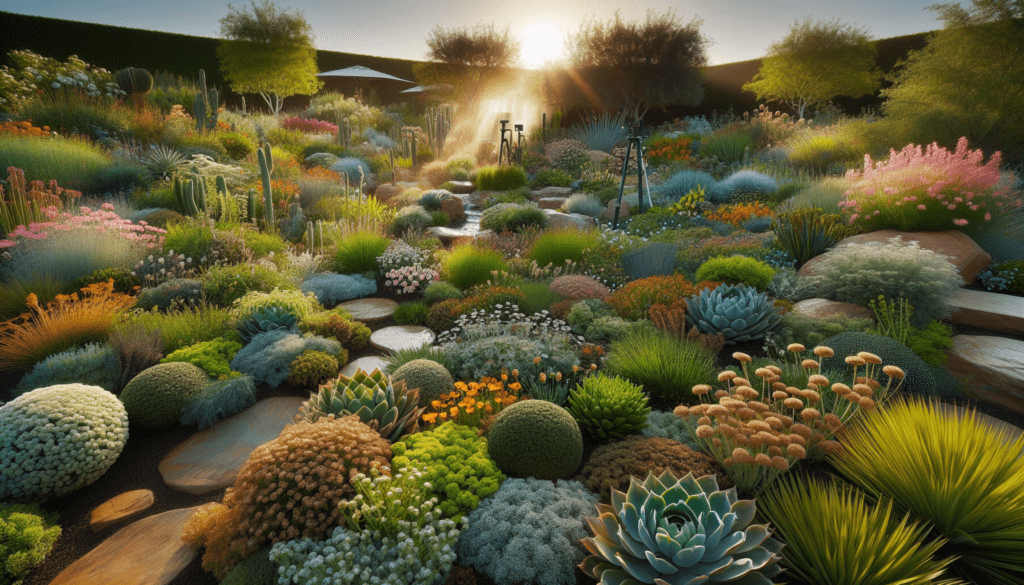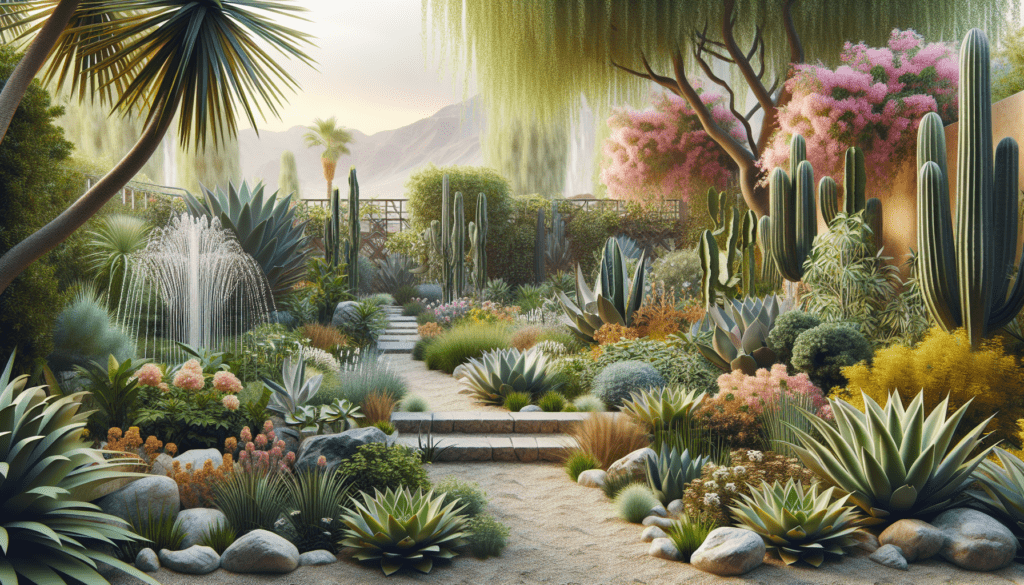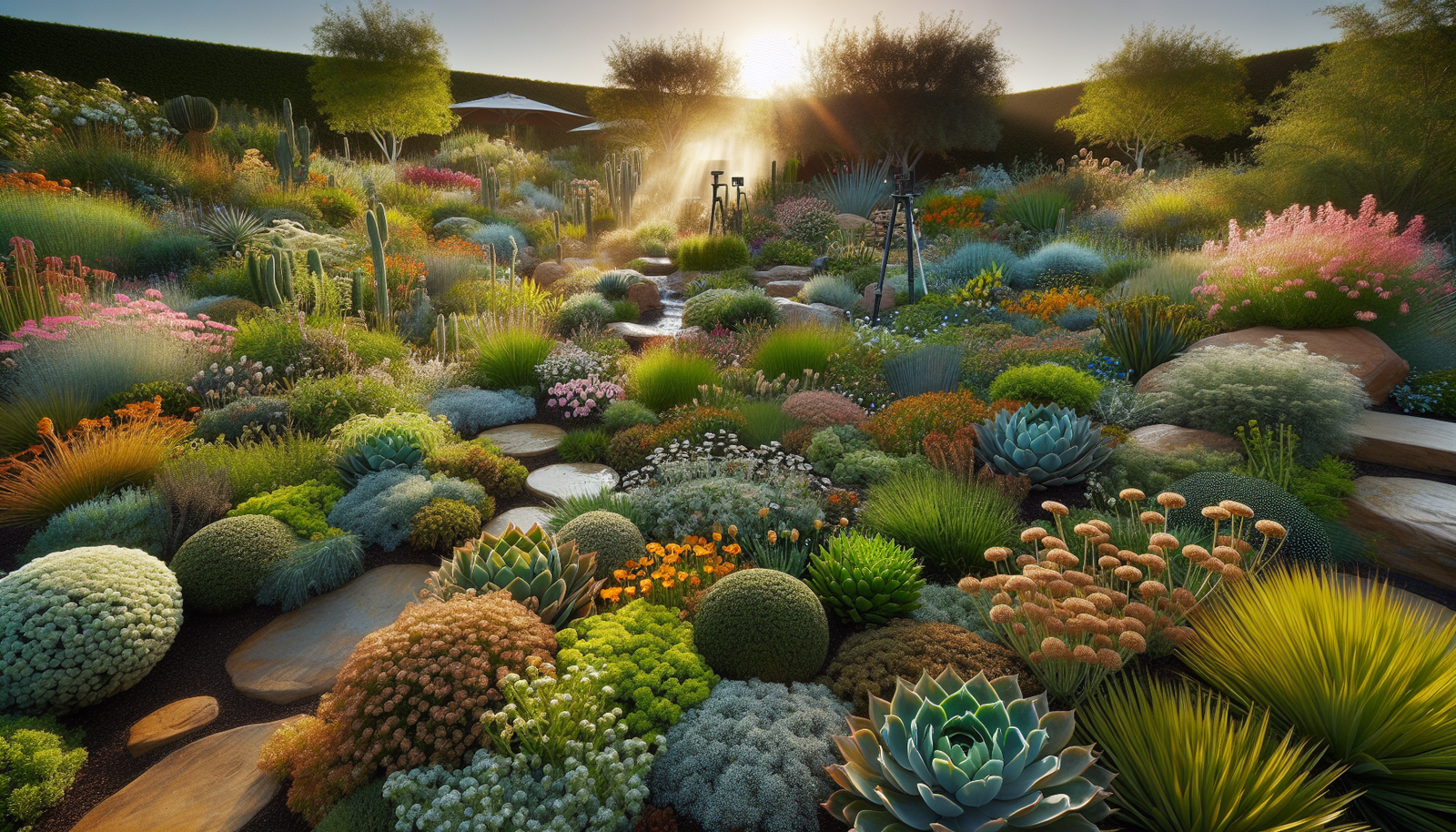Are you tired of trying to maintain a lush and vibrant garden in an arid climate, only to be met with frustration and disappointment? Look no further! This article is your essential guide to xeriscaping, the practice of gardening in dry and water-scarce environments. Discover innovative techniques and expert tips on how to create a beautiful, sustainable, and low-maintenance garden that thrives in arid climates. Say goodbye to constant watering and hello to a stunning garden that will make your neighbors green with envy.

Benefits of Xeriscaping
Reduced water usage
One of the key benefits of xeriscaping is its ability to significantly reduce water usage. Traditional gardens often require a large amount of water to thrive, especially in arid climates where water is scarce. Xeriscaping, on the other hand, focuses on using water-efficient techniques and plants that require minimal watering. By implementing xeriscaping principles in your garden, you can conserve water and reduce your overall water bill.
Lower maintenance requirements
Another advantage of xeriscaping is its lower maintenance requirements compared to traditional gardens. Xeriscaped gardens are designed to be sustainable and self-sufficient, which means less time and effort spent on watering, mowing, and pruning. Xeriscape plants are well-adapted to arid climates and require less care and maintenance. This not only saves you time, but also reduces the need for chemical fertilizers and pesticides.
Conservation of natural resources
Xeriscaping promotes the conservation of natural resources. By using drought-tolerant plants, you are reducing the demand for water and minimizing the strain on local water sources. Xeriscaping also encourages the preservation of native plants, which are well-suited to the local climate and require less water and maintenance. By choosing plants that are adapted to your specific climate zone, you are supporting biodiversity and preserving the natural environment.
Researching Your Climate
Understanding arid climates
Before starting your xeriscaping project, it’s essential to understand the characteristics of arid climates. Arid climates are known for their low precipitation levels and high evaporation rates. The hot and dry conditions make it challenging for plants to thrive without sufficient water. By understanding the challenges posed by arid climates, you can make informed decisions about the types of plants and techniques that will work best in your garden.
Determining your specific climate zone
Every region has different climate zones, each with its own unique set of climatic conditions. It’s important to determine your specific climate zone before selecting plants for your xeriscape. This information can be obtained from local gardening resources, agricultural extension offices, or online climate zone maps. By knowing your specific climate zone, you can choose plants that are well-suited to the temperature ranges, rainfall patterns, and soil types in your area.
Choosing Drought-Tolerant Plants
Native plants
Native plants are an excellent choice for xeriscaping because they are naturally adapted to the local climate and soil conditions. These plants have evolved to withstand and thrive in arid conditions, making them highly drought-tolerant. Native plants also play an important role in supporting local ecosystems, providing food and shelter for native wildlife. When selecting native plants for your xeriscape, consider their water requirements, growth habits, and aesthetic appeal.
Drought-resistant non-natives
In addition to native plants, there are also many non-native plants that are well-suited to xeriscaping. These drought-resistant non-natives come from regions with similar climatic conditions and can adapt well to arid landscapes. When choosing non-native plants, it’s important to research their water needs, invasive potential, and compatibility with the local ecosystem. Look for plants that have been proven to thrive in your climate zone and require minimal watering and maintenance.
Suitability to your climate zone
When selecting plants for your xeriscape, it’s crucial to consider their suitability to your specific climate zone. Some plants may be labeled as drought-tolerant or low-water, but they may not be well-suited to the temperature extremes or soil conditions in your area. Make sure to research and choose plants that are appropriate for your climate zone, taking into account factors such as temperature ranges, rainfall patterns, and soil types. Consulting with local gardening experts or nurseries can provide valuable insights into the best plant choices for your region.
Designing Your Xeriscape
Planning your garden layout
Designing a xeriscape involves careful planning to ensure optimal water efficiency and aesthetic appeal. Start by analyzing your outdoor space and identifying areas with different sun exposures and soil conditions. Consider the natural flow of water and plan your garden layout accordingly. Group plants with similar water needs together to make watering more efficient. Incorporate walkways, seating areas, and focal points to create a visually appealing and functional xeriscape design.
Grouping plants with similar water needs
Grouping plants with similar water needs is a vital aspect of xeriscape design. By organizing plants based on their water requirements, you can avoid overwatering or underwatering certain areas of your garden. This practice maximizes water efficiency and ensures that each plant receives the appropriate amount of water. Consider factors such as sun exposure, soil type, and plant size when grouping plants with similar water needs together.
Creating focal points and visual interest
In order to create an aesthetically pleasing xeriscape, it’s important to incorporate focal points and visual interest. This can be achieved through the use of hardscape elements, such as rocks, sculptures, or water features, as well as carefully chosen plants and flowers. Consider the various textures, colors, and heights of the plants you select to create a visually appealing arrangement. By strategically placing focal points throughout your xeriscape, you can draw the eye and create a sense of balance and harmony.

Soil Preparation
Assessing and improving soil quality
Before beginning your xeriscaping project, it’s crucial to assess the quality of your soil. Arid climates often have soil that is low in organic matter and nutrients, making it less fertile. Test your soil’s pH level and composition to determine if any amendments are necessary. Adding organic matter, such as compost or well-rotted manure, can improve soil structure, increase water retention, and provide essential nutrients for plant growth. Incorporating soil amendments before planting will help create a fertile and healthy growing environment for your xeriscape.
Adding organic matter
One of the key components of healthy soil is organic matter. Adding organic matter to your soil provides numerous benefits, including improved water retention, enhanced nutrient availability, and increased microbial activity. Organic matter can be in the form of compost, leaf mold, or well-rotted manure. Work the organic matter into the top few inches of soil to promote healthy root development and improve overall soil structure.
Enhancing drainage
In arid climates, proper drainage is essential to prevent waterlogging and root rot. Before planting your xeriscape, assess the drainage capabilities of your soil. If your soil tends to be compacted or holds water for extended periods, consider incorporating materials such as sand or gravel to improve drainage. Raised beds or mounded soil can also help promote better drainage. Ensuring that excess water can freely drain from your soil will prevent water-related issues and promote healthier plant growth.
Efficient Irrigation Techniques
Drip irrigation systems
Drip irrigation is an efficient and water-saving technique commonly used in xeriscaping. This method involves delivering water directly to the plant’s roots using a network of hoses or tubing with small emitters. Drip irrigation minimizes water loss through evaporation and runoff by delivering small, precise amounts of water directly to the root zone. This targeted approach ensures that plants receive the necessary moisture without wasting water in unplanted areas or on non-drought-tolerant surfaces.
Mulching
Mulching is an important practice in xeriscaping that helps conserve moisture and reduce weed growth. Applying a layer of organic mulch, such as wood chips, bark, or straw, around your plants helps retain soil moisture by preventing evaporation. Mulch also acts as an insulating layer, protecting plant roots from temperature extremes. Additionally, mulch inhibits weed growth by blocking sunlight and preventing weed seeds from germinating. Regularly replenishing mulch throughout the year will maximize its benefits and contribute to water conservation in your xeriscape.
Rainwater harvesting
Rainwater harvesting is a sustainable practice that can be integrated into your xeriscape to maximize water conservation. By collecting and storing rainwater, you can supplement your irrigation needs without relying solely on municipal water sources. Rain barrels or larger cisterns can be used to capture rainwater from downspouts or rooftops. This harvested rainwater can then be used for watering plants during dry periods, reducing your reliance on potable water. Using rainwater also ensures that your plants receive water that is naturally free of chemicals such as chlorine.
Watering Strategies
Watering schedules
Establishing a consistent watering schedule is crucial for the success of your xeriscape. While xeriscape plants are generally drought-tolerant, they still require regular watering to establish deep and healthy root systems. Watering in the early morning or late evening is recommended to minimize water loss through evaporation. It’s important to provide enough water to penetrate the root zone and encourage deep root growth. Monitor the moisture levels of your soil and adjust your watering schedule based on rainfall and seasonal variations.
Deep watering techniques
Deep watering techniques are essential for promoting deep root growth and drought tolerance in xeriscape plants. Rather than frequent shallow watering, it’s more effective to water deeply and less frequently. This encourages plants to extend their roots deeper into the soil where they can access water reserves during dry periods. Consider using drip irrigation or soaker hoses to deliver water directly to the root zone, allowing it to penetrate deeply and encourage stronger, more resilient plants.
Avoiding runoff and evaporation
To minimize water waste, it’s important to avoid runoff and evaporation when watering your xeriscape. Runoff occurs when the soil cannot absorb water quickly enough, resulting in water flowing away from the plants. To prevent runoff, water your plants slowly and consistently, allowing the water to be absorbed gradually. Mulching can also help prevent runoff by improving the soil’s ability to retain moisture. Additionally, watering during the early morning or late evening, when temperatures are cooler and evaporation rates are lower, can further reduce water loss.
Weed Control and Pest Management
Preventing weed growth
Weed control is an integral part of maintaining a healthy xeriscape. Weeds compete with your plants for water and nutrients, potentially hindering their growth and vitality. To prevent weed growth, applying a layer of mulch around your plants can act as a physical barrier, preventing weed seeds from germinating. Regularly inspect your xeriscape and remove any weeds that emerge promptly. Hand weeding or using specialized weeding tools can target weeds without disturbing your established plants.
Using organic pest control methods
In xeriscapes, it’s important to prioritize organic pest control methods to maintain a healthy and sustainable garden ecosystem. Chemical pesticides can disrupt the delicate balance of beneficial insects and pollinators that play a vital role in xeriscape gardening. Instead, opt for natural pest control methods such as introducing beneficial insects, using insecticidal soaps, or utilizing companion planting techniques. By promoting biodiversity and natural pest control, you can effectively manage pests while safeguarding the overall health of your xeriscape.
Companion planting for pest management
Companion planting is an effective technique for pest management in xeriscaping. By strategically combining certain plants, you can deter pests or attract beneficial insects that help control harmful pests. For example, planting marigolds around your vegetable garden can help repel pests such as aphids and nematodes. Similarly, attracting pollinators like bees and butterflies through the use of flowering plants can create a more balanced ecosystem and improve overall garden health. Researching and implementing companion planting techniques specific to your region can greatly contribute to successful pest management in your xeriscape.
Maintenance Tips
Regular monitoring and adjustment
Regular monitoring and adjustment are key to maintaining a healthy and thriving xeriscape. Routinely inspect your plants for signs of stress, disease, or pest infestations. Adjust your irrigation schedule as needed based on the weather conditions, rainfall, and plant requirements. Keep an eye on the growth habits of your plants to prevent overcrowding or competition for resources. By staying proactive and addressing issues promptly, you can ensure the long-term success of your xeriscape.
Pruning and deadheading
Pruning and deadheading are essential maintenance tasks in xeriscaping. Pruning helps maintain the size, shape, and health of your plants by removing dead or damaged branches. It also promotes better air circulation and sunlight penetration, reducing the risk of fungal diseases. Deadheading, or removing spent flowers, encourages continuous blooming and redirects the plant’s energy towards new growth. Regularly pruning and deadheading your plants will not only keep them looking tidy but also promote their overall health and vigor.
Proper fertilization practices
While xeriscape plants generally require less fertilization than traditional garden plants, they can still benefit from periodic nutrient boosts. Use slow-release or organic fertilizers specifically formulated for drought-tolerant plants, following the label instructions for application rates. Avoid over-fertilizing as it can lead to excessive vegetative growth and increase water demands. Instead, focus on maintaining a balanced and appropriate nutrient supply to support the health and vitality of your xeriscape plants.
Xeriscaping on a Budget
Choosing cost-effective plants
Xeriscaping doesn’t have to break the bank. By carefully selecting cost-effective plants, you can create a beautiful and sustainable xeriscape on a limited budget. Consider purchasing smaller-sized plants or choosing varieties that are easily propagated from cuttings or seeds. Local plant sales, nurseries, or gardening associations often offer discounts or promotions, providing an opportunity to acquire plants at lower costs. Additionally, researching and incorporating native plants can be a cost-effective choice, as they are naturally adapted to the local climate and require less maintenance.
DIY irrigation systems
Building your own DIY irrigation system is an effective way to save money in xeriscaping. There are various cost-efficient options to consider, such as installing drip irrigation systems using basic plumbing components or repurposing materials like PVC pipes or soaker hoses. Online tutorials and guides are available to help you design and install your own irrigation system that suits your specific garden layout and water requirements. By investing time and effort into DIY irrigation, you can achieve water efficiency while minimizing expenses.
Utilizing recycled materials
Utilizing recycled materials is not only environmentally friendly but also cost-effective in xeriscaping. Look for opportunities to repurpose materials such as old bricks, stones, or pallets for hardscape elements like pathways or raised beds. Reusing containers, such as buckets or barrels, for storing rainwater or creating self-watering planters can save money on purchasing new equipment. Get creative and explore local salvage yards, thrift stores, or online marketplaces for affordable recycled materials that can enhance your xeriscape design without breaking the bank.
In conclusion, xeriscaping offers numerous benefits for gardening in arid climates. By reducing water usage, lowering maintenance requirements, and conserving natural resources, xeriscaping provides a sustainable and environmentally friendly approach to landscaping. By researching your climate, choosing drought-tolerant plants, designing your xeriscape thoughtfully, preparing your soil, and implementing efficient irrigation techniques, you can create a beautiful and thriving xeriscape garden. With proper watering strategies, Weed control and pest management, regular maintenance, and cost-effective approaches, you can enjoy the benefits of xeriscaping while minimizing your ecological footprint and maximizing your enjoyment of your outdoor space.

